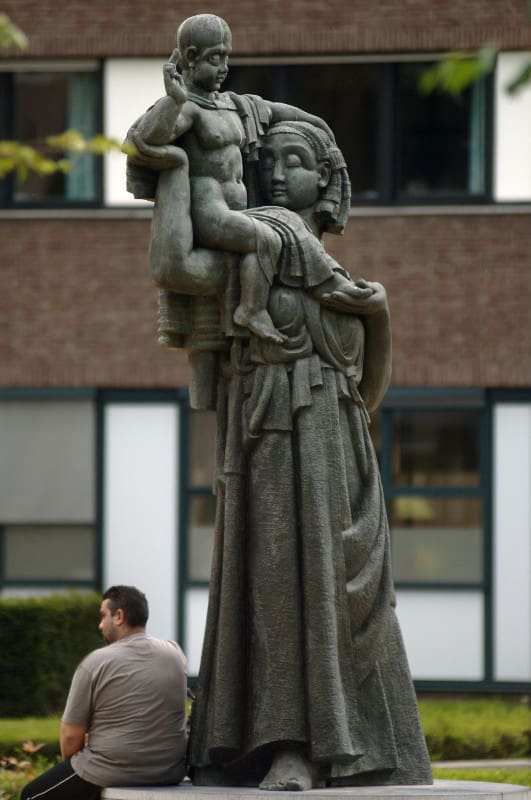MARIA MIDDELARES (KAREL AUBROECK)
In the Moerlandstraat, right in front of the main entrance to the hospital AZ Nikolaas, stands the large statue ‘Maria Middelares’.
The title of this sculpture, made in 1932, refers to the former name of the catholic hospital Maria Middelares, which is now part of AZ Nikolaas. The sculptor is Karel Aubroeck from Temse. Having been a soldier at the front, he knew the horrors of the great War (1914-1918). Aubroeck is a sensitive man but also a passionate idealist. This combination of qualities resulted in the artist’s expressionist work. In catholic faith, the Holy Virgin’s role as a mediator expresses the unique bond of Mary with the godly son Jesus. However, the artist doesn’t depict an evangelical Mary. He chose for a rather human version: a robust lady who is aware of her presence in this world, despite her downcast eyes . The folds of her gown and her dignified posture do however lend her the status of a classical goddess. The child does not lie tenderly in her arms but sits triumphantly, well-muscled and powerfully on her shoulder.
Originally Aubroeck was a woodcarver in the furniture industry. The decorations on his sculptures refer to this. He models in clay, cuts in stone and carves in wood. Thanks to his thorough knowledge of wood as material he made unequalled masterpieces like ‘De Wekroep (the Wakeup call)’ in the Vredeszaal of the City Hall. He focuses on monumental constructivist sculpture and reveals himself as one of our greatest monumental open air sculptors. In this area of expertise, he must consider perspective and the breaking away of shapes under the effect of distance and lighting. The sculptor is keenly aware of these effects.
Aubroeck enjoys renown far beyond the Waasland region. Some of his works are: the statue of king Albert I in the war monument at Nieuwpoort and the four statues at the Paxpoort (Pax Gate) IJzermonument in Diksmuide (1930). While executing these, he lost his left eye by flying chips.
At the 1935 World Exhibition in Brussels he displays the more than life-size statue ‘Vrouw met Lier (Woman with lyre)’ and on the 1937 World Exhibition in Paris the mahogany statue ‘Bescherming (Protection)’ or ‘Angst (Fear)’.
Karel Aubroeck was one of the most famous 20th century Flemish sculptors. He studied at the Academy of Temse. Later he trained as a wood carver in Mechelen. In 1914 he was awarded a gold medal for sketching after a live model. After 1918 he studied at the Academy of Mechelen. Aubroeck’s style is mostly expressionist, with a characteristic closed character. In 1922 he became a member of the Wase Kunstkring, where he had his first exhibition. From 1922 till 1968 he took part in exhibitions of the Wase Kunstkring and in four Biennals in the Middelheimmuseum. He was also chairman of the Royal Flemish Academy.
2008

